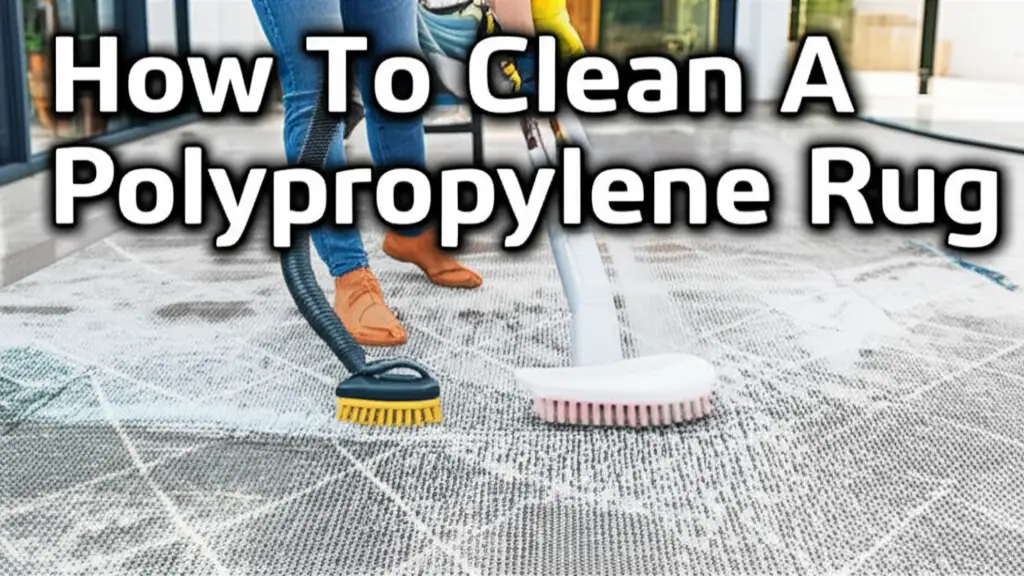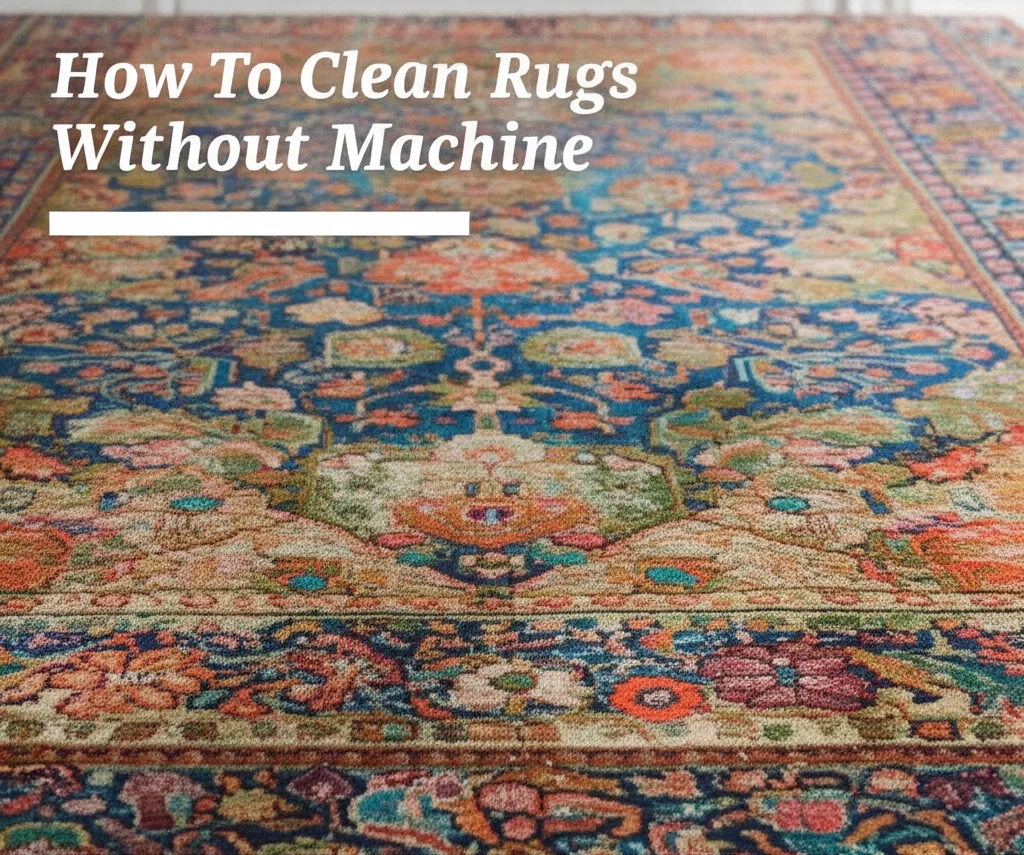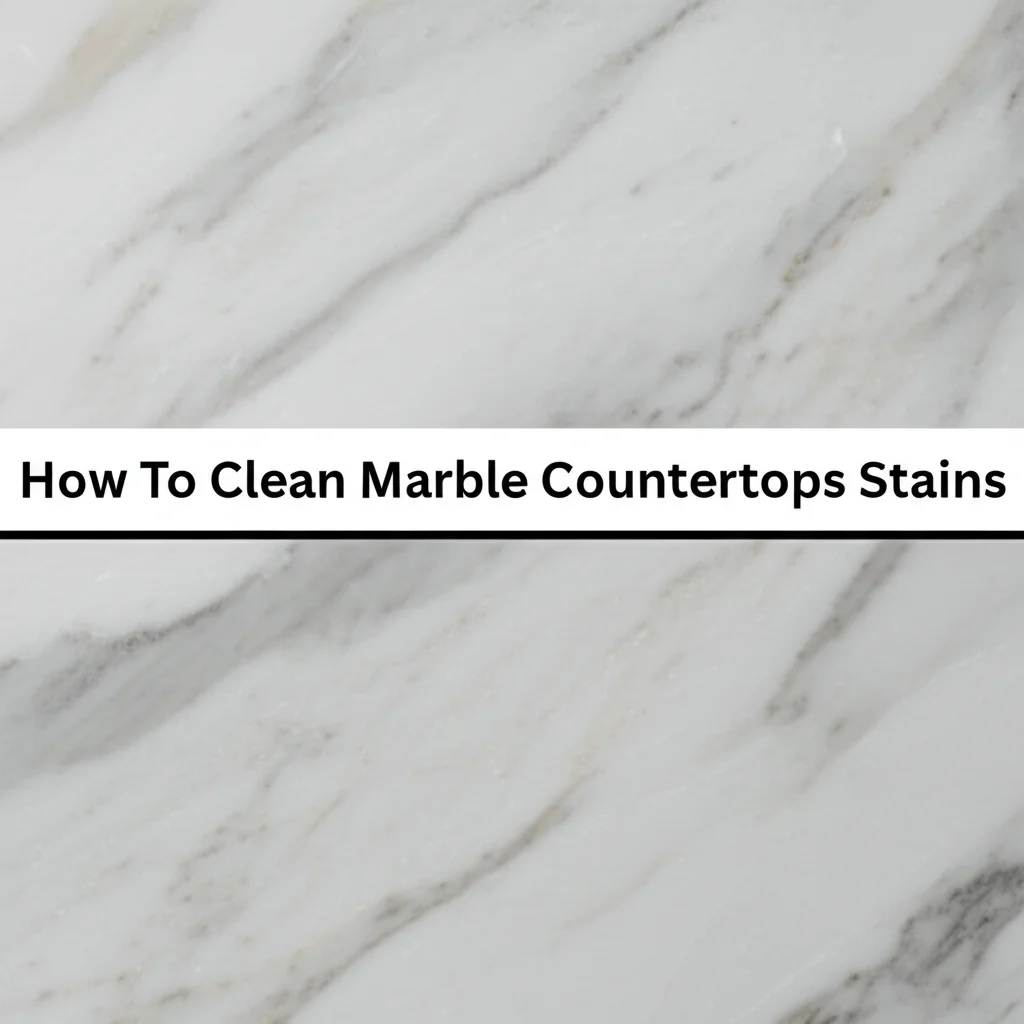· Todd Martin · Home Cleaning · 13 min read
How To Clean A Polypropylene Rug

How To Clean A Polypropylene Rug: Complete Care Guide
Polypropylene rugs offer a perfect blend of durability and affordability, making them a popular choice for both indoor and outdoor spaces. However, even these resilient floor coverings require proper cleaning to maintain their appearance and longevity.
This comprehensive guide provides step-by-step instructions on how to clean a polypropylene rug effectively using various methods, from regular maintenance to tackling stubborn stains.
Key Takeaways
- Polypropylene rugs are stain-resistant and can be cleaned with mild soap and water
- Regular vacuuming prevents dirt buildup and extends rug life
- Different cleaning methods work for different stains (spot cleaning vs. deep cleaning)
- Both hand washing and machine washing are possible for many polypropylene rugs
- Proper drying techniques prevent mold and mildew growth
What is a Polypropylene Rug?
Polypropylene (also known as olefin) is a synthetic fiber widely used in rug manufacturing due to its exceptional durability and resistance to stains, moisture, and fading. These rugs are ideal for high-traffic areas and homes with children or pets.
Characteristics of Polypropylene Rugs:
- Water-resistant
- Stain-resistant
- Fade-resistant
- Durable and long-lasting
- Affordable compared to natural fiber alternatives
- Available in various styles and designs
Understanding your polypropylene rug’s specific characteristics is crucial before applying any cleaning method. While most are highly durable, checking the manufacturer’s care instructions can prevent potential damage.
How to Clean a Polypropylene Rug by Hand
Hand washing is suitable for most polypropylene rugs and allows you to control the cleaning process. This method is ideal for routine cleaning or addressing specific stained areas.
Materials You’ll Need:
- Mild dish soap or specialized rug cleaner
- Soft bristle brush or sponge
- Clean white towels
- Bucket of warm water
- Garden hose (for outdoor cleaning)
- Squeegee (optional)
Step-by-Step Hand Washing Process:
Test for colorfastness: Apply a small amount of your cleaning solution to an inconspicuous area and wait 10 minutes to ensure it doesn’t cause discoloration.
Vacuum thoroughly: Remove loose dirt and debris before introducing water.
Prepare the cleaning solution: Mix one tablespoon of mild dish soap with two cups of warm water. Avoid hot water as it can damage the fibers.
Apply the solution: Using a soft brush or sponge, gently work the solution into the rug. Work in small sections and avoid saturating the rug.
Scrub gently: For stubborn stains, use a soft-bristled brush in a circular motion, but avoid aggressive scrubbing that could damage fibers.
Rinse thoroughly: Use clean water to remove all soap residue. Soap left behind can attract more dirt.
Remove excess water: Press clean towels onto the rug to absorb moisture or use a squeegee to push out excess water.
Dry completely: Allow the rug to dry thoroughly, preferably in sunlight, which also helps disinfect naturally. Ensure both sides are completely dry before returning the rug to its place.
For smaller rugs, you might find it easier to take them outside where you can use a garden hose for the rinsing process.
Can You Clean a Polypropylene Rug in a Washing Machine?
One of the advantages of polypropylene rugs is that many smaller ones can be machine washed, which is not true for most other rug materials. However, there are important considerations before tossing your rug in the washer.
When Machine Washing is Appropriate:
- The rug is small enough to fit comfortably in your machine
- The care label specifically states machine washing is acceptable
- The rug doesn’t have a rubber backing that could deteriorate
- Your machine has appropriate settings for gentle cleaning
Machine Washing Instructions:
Check the manufacturer’s label first to confirm machine washing is safe.
Remove as much loose dirt as possible by shaking or vacuuming the rug.
Use a front-loading washing machine if possible, as top-loaders with agitators can be too rough.
Set the machine to a gentle or delicate cycle with cold water.
Use a mild detergent and avoid bleach or harsh chemicals.
After washing, don’t put the rug in the dryer unless the care label specifically allows it. Instead, hang it to air dry away from direct heat sources.
For larger polypropylene rugs that won’t fit in a home washing machine, consider using a laundromat with commercial-sized machines or opt for hand cleaning instead.
How to Clean a Polypropylene Rug with Vinegar
Vinegar is an excellent natural cleaning agent for polypropylene rugs, particularly for removing odors and light stains. Its acidic properties help break down dirt while being gentle enough not to damage synthetic fibers.
Vinegar Cleaning Solution Recipe:
- 1 part white vinegar
- 3 parts warm water
- 1 teaspoon of mild dish soap (optional, for extra cleaning power)
Using Vinegar for General Cleaning:
Vacuum the rug thoroughly to remove loose debris.
Mix the vinegar solution in a spray bottle or bucket.
Test in an inconspicuous area first to ensure no discoloration occurs.
Apply the solution to the rug using a spray bottle for controlled application.
Use a soft brush to work the solution gently into the fibers.
Allow the solution to sit for 5-10 minutes for stubborn stains or odors.
Rinse thoroughly with clean water to remove all vinegar residue.
Blot with clean towels and allow to dry completely.
The vinegar smell will dissipate as the rug dries, leaving your polypropylene rug fresh and clean.
Dealing with Specific Stains on Polypropylene Rugs
Despite their stain-resistant properties, polypropylene rugs can still fall victim to certain tough stains. Here’s how to address common problems:
Pet Stains and Odors
For fresh pet accidents:
- Blot up as much liquid as possible with paper towels.
- Apply an enzyme-based pet stain remover specifically designed for synthetic fibers.
- Allow the cleaner to sit according to package directions.
- Blot with clean water and dry thoroughly.
For set-in pet odors:
- Create a paste with baking soda and water.
- Apply to the affected area and allow to dry completely.
- Vacuum thoroughly to remove the dried baking soda.
- Follow with a vinegar solution cleaning if needed.
For persistent pet issues, you might want to check out how to clean urine from polypropylene rugs for more specific guidance.
Food and Beverage Stains
For coffee, wine, or juice stains:
- Blot immediately with clean, white cloths.
- Apply a solution of mild dish soap and warm water.
- For colored beverages, a solution of 1 part white vinegar to 1 part water can help remove color.
- For greasy food stains, apply a small amount of dish soap directly to the stain before general cleaning.
Mud and Dirt
For mud stains:
- Allow the mud to dry completely.
- Vacuum thoroughly to remove dried particles.
- Treat any remaining stain with the standard soap and water solution.
- For stubborn dirt, use a soft brush to gently agitate the fibers.
Can You Steam Clean a Polypropylene Rug?
Steam cleaning can be an effective method for deep cleaning polypropylene rugs, but it must be done correctly to avoid damage.
When Steam Cleaning Works Best:
- For deeply soiled rugs that haven’t responded to other cleaning methods
- For sanitizing rugs in homes with allergies or pets
- For refreshing rugs without using chemicals
Steam Cleaning Guidelines:
Ensure your steam cleaner has a synthetic rug setting or adjustable heat settings. Excessive heat can damage polypropylene fibers.
Use the lowest effective temperature setting, typically below 270°F (132°C).
Don’t let the steamer linger in one spot for too long.
Use minimal cleaning solution, preferably one designed for synthetic rugs.
Make sure to extract as much water as possible during the process.
Allow the rug to dry completely before replacing furniture.
If you’re unsure about steam cleaning your specific rug, consider consulting professional rug cleaning services who specialize in synthetic materials.
Can You Use a Carpet Cleaner on a Polypropylene Rug?
Carpet cleaners with appropriate settings can be used on polypropylene rugs, offering another effective deep cleaning option.
Using a Carpet Cleaner Effectively:
Choose a carpet cleaner with adjustable settings suitable for synthetic fibers.
Vacuum the rug thoroughly before using the carpet cleaner.
Use a cleaning solution specifically formulated for synthetic fibers.
Test in an inconspicuous area first.
Use minimal solution and water to prevent over-wetting.
Make several passes with just the extraction function to remove as much moisture as possible.
Allow the rug to dry completely on both sides.
For comparison with other rug types, you might find it helpful to review guides on how to clean a polyester rug or how to clean a sisal rug to understand the differences in cleaning approaches.
Drying Techniques for Polypropylene Rugs
Proper drying is crucial to prevent mold, mildew, and odors after cleaning your polypropylene rug.
Recommended Drying Methods:
Air drying outdoors: Hang the rug over a railing or lay it flat in a clean area with good airflow. Sunlight provides natural disinfection but limit exposure to 2-3 hours to prevent fading.
Indoor air drying: If outdoor drying isn’t possible, place the rug in a well-ventilated room. Use fans to increase air circulation.
Elevated drying: Place the rug on a clean, dry surface elevated off the floor to allow air circulation beneath.
Blotting technique: Use clean, dry towels to press out excess moisture before air drying.
Flip periodically: Turn the rug over halfway through drying to ensure both sides dry evenly.
Avoid using hair dryers or heaters directly on the rug, as excessive heat can damage polypropylene fibers or cause shrinkage.
Polypropylene Rug Safety and Environmental Considerations
While cleaning your polypropylene rug, it’s important to address common questions about safety and environmental impact.
Are Polypropylene Rugs Toxic?
Polypropylene itself is considered one of the safer synthetic materials. It’s:
- Low in VOC emissions compared to other synthetics
- Non-toxic in its stable form
- Generally hypoallergenic
However, some concerns exist:
- New rugs may have manufacturing chemicals that need to off-gas
- Some backing materials or adhesives might contain chemicals of concern
- Extremely high heat can potentially cause degradation
To minimize any concerns:
- Allow new rugs to air out in a well-ventilated area before use
- Vacuum regularly to remove dust and allergens
- Use gentle, non-toxic cleaners when possible
- Avoid excessive heat exposure
Eco-Friendly Cleaning Options
For environmentally conscious cleaning:
- Use plant-based or biodegradable cleaning products
- Opt for natural solutions like vinegar and baking soda
- Reduce water usage by spot cleaning when possible
- Avoid cleaners with phosphates, chlorine, or artificial fragrances
Proper maintenance not only keeps your rug looking great but also ensures you’re creating a healthy home environment.
Regular Maintenance for Polypropylene Rugs
The key to keeping your polypropylene rug looking fresh is regular maintenance. These simple practices will extend the life of your rug and reduce the need for deep cleaning.
Vacuuming Techniques
Regular vacuuming is the most important maintenance task for any rug, including polypropylene ones. Here’s how to do it properly:
- Vacuum at least once a week, or more frequently in high-traffic areas
- Use the appropriate vacuum setting for your rug’s pile height
- For flat-weave or low-pile rugs, use the bare floor setting
- For medium to high-pile rugs, use the carpet setting but disable the beater bar to prevent fiber damage
- Vacuum both sides of the rug when possible to remove deeply embedded dirt
For optimal results, consider using a vacuum with adjustable suction power. Too much suction can damage the fibers, while too little won’t effectively remove dirt particles.
Addressing Spills Immediately
One of the advantages of polypropylene rugs is their stain resistance. However, addressing spills promptly will ensure they don’t become permanent:
- Blot (don’t rub) the spill with a clean, white cloth to absorb liquid
- Work from the outside of the spill toward the center to prevent spreading
- For water-based spills, continue blotting until the area is nearly dry
- For oil-based spills, apply a small amount of dish soap diluted in warm water
- Rinse by blotting with clean water and then dry thoroughly
Quick action prevents stains from setting and makes the cleaning process much easier.
Preventative Measures for Polypropylene Rugs
The best cleaning strategy is preventing excessive soiling in the first place. These preventative measures will help maintain your polypropylene rug’s appearance between cleanings:
Use entryway rugs: Place mats at entrances to catch dirt before it reaches your main rugs.
Implement a no-shoes policy: Removing shoes at the door significantly reduces dirt and contaminants.
Apply rug protectors: Consider using a fabric protector designed for synthetic fibers for additional stain resistance.
Rotate regularly: Turn your rug 180 degrees every few months to ensure even wear.
Use rug pads: Quality rug pads provide cushioning, prevent slipping, and allow airflow under the rug.
Address spills immediately: The longer a spill sits, the more likely it will become a stain.
Keep pets groomed: Regular pet grooming reduces shedding and dander on your rugs.
These simple steps can dramatically extend the time between deep cleanings.
Frequently Asked Questions About Cleaning Polypropylene Rugs
What is the best cleaner for polypropylene?
The best cleaner for polypropylene rugs is usually a mild dish soap diluted in warm water. This gentle solution effectively removes most dirt and stains without damaging the synthetic fibers. For tougher stains, specialized synthetic rug cleaners or a vinegar solution can be effective alternatives that maintain the rug’s integrity and appearance.
Can you wash a 100% polypropylene rug?
Yes, you can wash a 100% polypropylene rug. These rugs are water-resistant and highly durable, making them washable by hand or, for smaller sizes, in a washing machine on a gentle cycle with cold water. Always check the manufacturer’s care label first, and allow the rug to air dry completely to maintain its shape and prevent mildew.
How do you clean a polypropylene carpet?
To clean a polypropylene carpet, start with thorough vacuuming to remove loose dirt. For general cleaning, use a solution of mild soap and warm water applied with a soft brush, working in small sections. For wall-to-wall carpeting, a carpet cleaner with appropriate settings for synthetic fibers works well. Always extract as much moisture as possible and ensure adequate drying time.
Is polypropylene easy to clean?
Polypropylene is one of the easiest rug materials to clean due to its inherent stain and water resistance. The synthetic fibers don’t absorb liquids readily, allowing spills to be blotted up before staining occurs. Most stains can be removed with simple soap and water, and the material stands up well to various cleaning methods without losing its appearance or durability.
Can you bleach polypropylene rugs?
While polypropylene is more chlorine-resistant than many fibers, using bleach is not recommended for routine cleaning. Bleach can potentially damage the backing, adhesives, or any natural fiber blends in the rug. For disinfecting purposes, use alternatives like vinegar, hydrogen peroxide, or specialized synthetic rug disinfectants that are safer for the material and your home environment.
How do you remove stains from a polypropylene rug?
Remove stains from a polypropylene rug by first blotting up any liquid with clean cloths. For water-based stains, use a solution of mild dish soap and warm water, working from the outside toward the center. For oil-based stains, dish soap works especially well. Tough stains may require a specific treatment: vinegar solution for organic stains, rubbing alcohol for ink, or enzyme cleaners for biological stains.
How often should I clean my polypropylene rug?
Polypropylene rugs should be vacuumed weekly (more often in high-traffic areas), spot-cleaned as stains occur, and deep-cleaned every 12-18 months depending on use. Rugs in high-traffic areas or homes with children and pets may require more frequent deep cleaning, while those in low-traffic areas might need less attention. Regular maintenance significantly extends the life and appearance of your rug.
Final Thoughts on Polypropylene Rug Care
Keeping your polypropylene rug clean doesn’t have to be complicated. With regular maintenance and prompt attention to spills, these durable synthetic rugs can maintain their appearance for many years. Whether you prefer hand washing, machine washing, or using specialized cleaning equipment, the key is to use gentle products and techniques appropriate for synthetic fibers.
Remember that different cleaning methods work better for different situations – spot cleaning for small stains, hand washing for routine maintenance, and deep cleaning methods for periodic refreshing. By following the guidelines in this article, you’ll be well-equipped to handle whatever cleaning challenges your polypropylene rug presents.
For more specific guidance on other rug types, explore our guides on how to clean a sheepskin rug or how to clean a shag area rug, which require different approaches than the relatively easy-care polypropylene.




